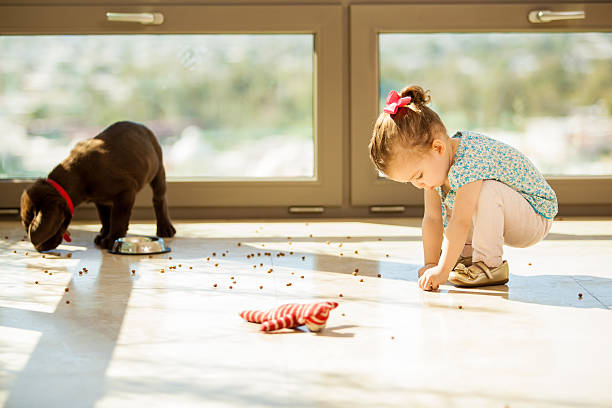Scientists have warned anything that touches the floor is at risk of E.coli or salmonella
– but are they right?
The ‘five-second rule’ is applied in households across the whole of Britain
But scientists claim any food which touches floor could be contaminated
The Daily Mail takes a closer look at whether the UK is playing the culinary equivalent of Russian roulette – or whether it might be making us healthier
We’ve all done it. Watched in horror as the piece of toast slips from our fingers and drops to the floor (landing butter-side down, of course) before deciding it’s OK to pick it up and eat it.
After all, it’s been on the floor less than five seconds. The ‘five-second rule’ — that unwritten edict which dictates that dropped food is fine as long as it’s picked up promptly — is applied in households across Britain, but scientists this week warned that any food that touches the floor should be binned, in case it picks up salmonella or E.coli bugs.
So are they right? Is eating dropped food the culinary equivalent of playing Russian roulette — or could it make us healthier?
SILENT KILLERS
This week hygienist Dr Lisa Ackerley warned that potentially lethal bacteria can rapidly colonise fallen food, pointing out that these silent killers multiply from a single bacterium to several million in just seven hours.
The three most worrying forms of infectious bacteria that could lurk on our floors are E.coli, staphylococcus aureus (S.aureus) and salmonella.
E.coli can cause diarrhoea and urinary tract infections, and even severe anaemia or kidney failure.
S.aureus is the leading cause of skin infections. It can also cause bloodstream and joint infections or pneumonia.
Salmonella symptoms include diarrhoea, stomach cramps, vomiting and fever. It causes around 80 deaths in the UK a year.
5 VITAL SECONDS
Research led by Anthony Hilton, a professor of applied microbiology at Aston University, Birmingham, shows 87 per cent of people say they would eat food dropped on the floor, or have done so. The majority follow the five-second rule.
So why isn’t the UK suffering huge epidemics of floor-acquired illness? Professor Hilton feels confident it is safe to pick up dropped food at home — as long as you move quickly enough.
‘I have three young boys who have grown up dropping toast on the floor and picking it up again,’ he has said. ‘In my own home, which I know to be hygienically clean, the risk of them picking up anything nasty with the toast is very, very low.’
His research team demonstrated that while some bacteria get transferred to food as soon as it lands on the floor, it takes time for them to transfer in enough numbers to cause illness.
‘The initial transfer of bacteria is insufficient to contaminate the food,’ says his report.
Hence, he concludes, the five-second rule does hold true for normally hygienic home floors — although street pavements may well be another matter, he adds.
CARPET IS BEST
Many of us pick up food dropped on a tiled or laminate kitchen floor, but draw the line at tucking into titbits that have fallen on fluffy carpets. But it seems we’ve got this the wrong way round.
Researchers at Aston University and Clemson University all found that tile, wood and laminate surfaces transfer many more bacteria than carpeted surfaces.
As both studies were observational, researchers didn’t explain why this is the case. But it seems that if food lands on a flat surface far more of it will come into contact with the floor.
WASH WEEKLY
Three-quarters of us clean our kitchen floor once a week — and that’s probably plenty. Experts recommend a common sense approach and say that as long as the floor looks spick and span, it should be clean enough to be hygienic.
But when you do get the mop out, you’d be wise to pay particular attention to the spot just in front of the sink — which harbours more bacteria than the bin.
‘The chances of you finding any nasty bacteria such as salmonella on your floor are not very high, if you keep your household reasonably clean,’ says Dr Clare Taylor, general secretary of the Society for Applied Microbiology.
‘I think the idea that our floors are covered with nasty infectious bacteria is just one of those self-perpetuating myths,’ she told us. ‘As a culture we are phobic about bacteria — and our cultural fear helps to propagate this myth.’
However, if you have pets in the house, you may need to reach for the floor cleaner more often. You never quite know where their paws have been. Dogs fed on raw food also have an increased risk of transmitting salmonella, according to research in the Canadian Veterinary Journal in 2007. Worst of all for salmonella, however, are reptiles such as terrapins and snakes.
FRIENDLY GERMS
Some scientists believe eating apparently ‘dirty’ food can help us to ingest friendly microbes and build our bodies’ defences.
The microbes living inside us outnumber our own human cells by ten to one. Research is revealing how ‘friendly’ bacteria can support our health in a surprising variety of ways, such as helping to prevent diabetes and skin infections, and protecting us from developing allergies such as asthma, psoriasis and eczema.
Friendly bacteria help to prevent infectious bugs from escaping through the lining of our stomachs and invading our bloodstream and organs.
Karen Amato, a professor of anthropology at Northwestern University in Illinois, has been studying how diets affect the bacterial balance in our stomachs.
She argues: ‘Unless you are dropping food in a doctor’s office or in a portable toilet, exposure to microbes is good. I say go ahead and eat it.
‘If there are microbes on that piece of food it could contribute to the development of the healthy immune system.’

























